- Publisher's Note
- Editorial
- Memories of a Master
- The Gallery as Print Studio
- Printer as Pedagogue
- Perspectives of an Outsider
- Ghosts in the Machines
- Digitalization and Contesting Digitalization
- The Body in Woodcut
- Evoking Symbol and Redefining Space
- The Almanac of Debian Delight
- Permanent State of Suspension
- Perspectives on Survival
- A Look at Printmakers from Australia, Canada and Bangladesh
- Atin Basak: His Artistic Pursuit
- Chor Bazaar, Mumbai
- Didn't We Often Wish We Lived in a Time of Ancient Glory
- The Buddhist Heritage of Pakistan: Art of Gandhara, the Asia Society Museum, New York
- Slivery Facets of Golden Diamonds from Golconda
- Ulysse Nardin: Keepers of History
- Venice Biennale
- What Happened with “Deconstruction India”
- Publication of Graphic Folio by the Members of Society of Contemporary Artists, 2010
- A Blitzkrieg of Creative Impulses
- Let's Paint the Sky Red- A Solo Show of Late Artist Manjit Bawa
- Raghu Rai: Invocation to India - A Variegated Matrix of the Human Predicament
- Rise of Prints
- The Story So Far
- What Happened and What's Forthcoming
- Art Bengaluru
- Art Events Kolkata
- Musings from Chennai
- Mumbai Art Sighting
- Few Printmakers from North East: A Brief Glance at the Contemporary Practices
- Previews
- In the News
ART news & views
Printer as Pedagogue
Volume: 4 Issue No: 20 Month: 9 Year: 2011
Feature
T. Sudhakar Reddy inspires the young and the rural at Andhra University
by Lina Vincent Sunish
It is interesting to investigate a link between the active practice of printmaking and the atmosphere created within a university curriculum by teachers. Looking at the Department of Graphics at Andhra University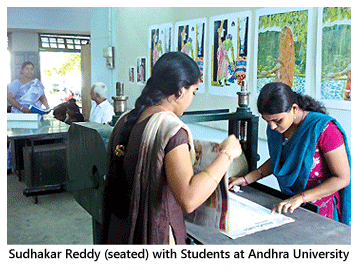 it is possible to develop a discussion about the realities (both advantageous and disadvantageous) faced by students from two-tier towns in their progress towards a successful artistic career. Vishakhapatnam is a growing coastal township in Andhra Pradesh (AP) in southern India. Despite its status as an important port, the city, like other smaller cities in India, lies in the shadow of the state's capital Hyderabad.
it is possible to develop a discussion about the realities (both advantageous and disadvantageous) faced by students from two-tier towns in their progress towards a successful artistic career. Vishakhapatnam is a growing coastal township in Andhra Pradesh (AP) in southern India. Despite its status as an important port, the city, like other smaller cities in India, lies in the shadow of the state's capital Hyderabad.
There is an understandable relationship between the practice of a medium and the institutions that impart art education. A majority of practicing artists in India are affiliated to institutions that they have studied in, and/or that they teach in. In the case of printmaking history in India such relationships are notable: the departments at Visva Bharati Santiniketan and M.S. University Baroda being significant examples. Hyderabad in AP state is home to established printmakers like Laxma Goud and D.L.N Reddy, who in turn have taught younger generations of practicing printmakers. It is possible to spot a pattern in the practice of the medium and it is noticeable that a large group of young artists who have studied at the Andhra University (AU) Department of Graphics under the guidance of T. Sudhakar Reddy, printmaker and Associate Professor, strongly continue to identify their art-making with Professor Reddy's pedagogy.
The Fine Arts section at Andhra University (AU), Vishakhapatnam was started in 1977 under the headship of Mr. M.R. Apparao, and within this, a specialisation in Printmaking was initiated in 1987 under Y. V. Laxmaiah. 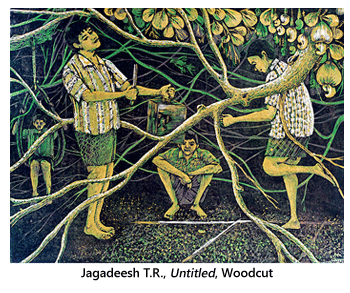 The Fine Arts section takes a maximum of 20 students a year, sometimes less. The different specialisations, under the tutelage of V. Ramesh (Painting), Ravinder Reddy (Sculpture) and T. Sudhakar Reddy (Graphics) are small and compact and have students from each of the four years interacting closely with the instructors across departments. Noteworthy young printmakers who have passed through AU are Kodanda Rao, Simhachalam D., Kurma Nadham, Jagadeesh T. R., Soghra Khurasani, Prathap Modi and Balaji Ponna. Several of these young artists have now settled in Baroda.
The Fine Arts section takes a maximum of 20 students a year, sometimes less. The different specialisations, under the tutelage of V. Ramesh (Painting), Ravinder Reddy (Sculpture) and T. Sudhakar Reddy (Graphics) are small and compact and have students from each of the four years interacting closely with the instructors across departments. Noteworthy young printmakers who have passed through AU are Kodanda Rao, Simhachalam D., Kurma Nadham, Jagadeesh T. R., Soghra Khurasani, Prathap Modi and Balaji Ponna. Several of these young artists have now settled in Baroda.
T. Sudhakar Reddy was born in a village in Nalgonda district of AP state. After completing a graduation in science, he took up agriculture at his ancestral property; however, he always looked towards art as something that could be socially relevant and create change. This led him to join the department of Fine Arts at MSU Baroda at the age of 26. He was taught by stalwarts Nasreen Mohamedi and Nilima Sheik. He remembers the former for her emphasis on discipline and a high standard of drawing, and the latter for introducing him to art history among other things. After his MA in Graphics at MSU, he returned to Hyderabad where he wanted to start a school for the underprivileged. Though he could not realise this, he continued to work at the Lalit Kala Academi studio, where D.L.N. Reddy, Laxma Goud, P.T. Reddy and others produced prints.
In 1987 he joined his former batch-mates V. Ramesh and Ravishankar Patnaik at AU when a decision was made to review the Fine Arts curriculum and introduce specialisations. He continued to produce work for exhibition during the next five years, but later concentrated purely on teaching. The students in the fine arts section at Andhra University are mostly from rural backgrounds, 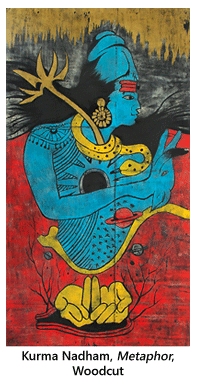 many of them belonging to poor families, and some of them entering fine arts as a last resort. Somewhere along the way Reddy realised that in teaching art in this environment he was connecting with his aim of deriving a socially meaningful function from art practice.
many of them belonging to poor families, and some of them entering fine arts as a last resort. Somewhere along the way Reddy realised that in teaching art in this environment he was connecting with his aim of deriving a socially meaningful function from art practice.
Conditions in his department are creating a fertile ground for printmaking practice. On speaking to several of his ex-students, the fact appears that he never demonstrates his own work or uses materials in a class room, which is surprising in the case of a very technical medium like printmaking. Soghra Khurasani, who studied painting but actively creates prints, says, “It is through words that Sudhakar Reddy taught us everything regarding printmaking.” His ability to communicate and establish a rapport with the students seems to have proved extremely effective considering the way they continue to work. Many students of Sudhakar Reddy's go on to pursue post graduate courses in larger institutions like M.S. U. Baroda, Visva Bharati Santiniketan or to a lesser extent, the College of Fine Arts Hyderabad. For most of them, their initial stages in these new institutions are difficult due to marked differences in language, culture, and pedagogical structures. Systems of hierarchy in the Indian context tend to privilege those coming from cosmopolitan backgrounds and undervalue and suspect the abilities of those from semi-urban and rural environments. In Sudhakar Reddy's opinion, the majority of his students have circumvented this notion through sheer hard work; their skill and creativity communicating for them and helping them gain acceptance. It is not by rejecting their various rural roots, but rather by embracing their backgrounds that brings them recognition. “I like to help them see where they have come from and acknowledge it. Most of their imagery comes from their roots, their cultures,” he says. This is visible in the works of Jagadeesh T. R. and Kurma Nadham.
One of the factors emphasised by Reddy is drawing. Foundational level students sketch at least twenty drawings per day, and later it is this exercise that stands them in good stead, regardless of what mediums they choose to work with. Prathap Modi remembers Sudhakar Reddy telling the students, "Don't think, just do work". He mentions that he gained a lot from interactions with V. Ramesh as well. Kurma Nadham works with several forms of printmaking, including iron engraving, woodcut and aquatints. He avers that Sudhakar Reddy not only teaches but encourages students in many ways.
Simhachalam, who now teaches in the department alongside his mentor agrees, “When Sudhakar takes a class he includes the whole universe in his discussion." This ties-in with what Reddy himself states: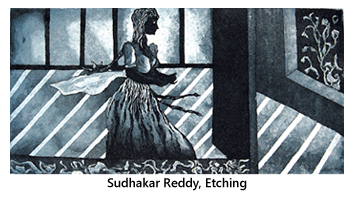 “Teaching is not just giving information and technical details. It is a one-to-one conversation. One must know their (students) abilities and take them into confidence.” His method is to bring up different subjects in daily interactions, to which the students respond slowly, learning along the way. When they learn to "sit and work" dedicatedly, whatever their background, it helps them understand what they can achieve, with a minimum of infrastructure (this is one of the realities in the department). He has seen amazing transformations in students who have started out raw and accomplished much before and after leaving the college.
“Teaching is not just giving information and technical details. It is a one-to-one conversation. One must know their (students) abilities and take them into confidence.” His method is to bring up different subjects in daily interactions, to which the students respond slowly, learning along the way. When they learn to "sit and work" dedicatedly, whatever their background, it helps them understand what they can achieve, with a minimum of infrastructure (this is one of the realities in the department). He has seen amazing transformations in students who have started out raw and accomplished much before and after leaving the college.
Sudhakar Reddy is currently completing his final year of Professorship after twenty five fulfilling years. Looking back through the time he spent teaching at AU, he recounts how he enjoyed every bit, and never considered it as work. “I believed in their (students) strengths; they believed in my word(s), we evolved together” he says. During his tenure he has also been actively involved in experimentation. Monochromatic printing is common, not only because of the strong graphic quality, but also due to the process involved in producing multicoloured images. The department could not afford viscosity1 rollers. Trying to find an alternative for 'local inking'2 in different colours to create a colour image, Reddy and his students began a new method. The plate, inked with the first colour was printed on a thin dry tracing paper; this print was put through the press immediately with the final paper to transfer the image a second time. The plate was cleaned, burnished, scraped and re-inked with a different colour and the process was repeated for every fresh colour (with registration) to successfully produce a multicoloured image with a variety of tonalities and lines. (This experiment was made with both dry and wet papers). The process allowed for the original image to be printed without the obligatory reversal (because it is transferred twice), and further trials proved that the process could be used to transfer to a glass surface too, by replacing ink with glass colours. Reddy believes that rather than see the technicalities of printmaking as limitations, it is possible for artists to achieve what they want from an image by working out a strategy.
On being asked why he gave up exhibiting and selling his work, he says “Teaching itself is an interesting creative profession. You cannot do justice to both active practice and teaching.” He also believes that in the competitive commercial world time is money, and on the other hand teaching takes time, so he made a choice. It does not mean that he left his personal work all together. He still makes prints at leisure, at home and in studios other than his department. His works have been mostly etchings in small sizes. His aquatints are soft, with gradual variations of tone from light to dark achieved by using an extremely diluted acid bath with the plate being dipped up to 50 times in sequence. His inspiration comes from his surroundings and the natural world; his images are mostly figurative with an added element of mystery through abstract sections.3 Over the years,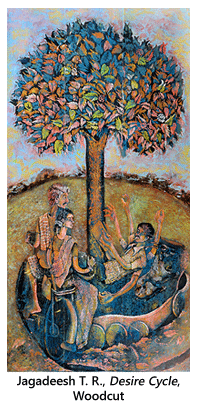 he has also actively worked with local craft and folk art, and engages in developmental workshops and training programs for artisans, particularly women. His students are always included in these activities.
he has also actively worked with local craft and folk art, and engages in developmental workshops and training programs for artisans, particularly women. His students are always included in these activities.
Jagadeesh T. R., a recent graduate from the department currently pursuing post graduation in Graphics at Baroda says that Sudhakar Reddy opened the world of techniques to him and made him aware of the possibilities of printmaking. Jagadeesh makes coloured woodcuts in monumental sizes, and he owes his exploration of line and texture to the qualities of the medium, and how he was taught at AU. Kodanda Rao, another ex-student adds that Reddy helps students both practically and psychologically and teaches them the skills to be individualistic and independent. Balaji Ponna calls him a very good motivator.
The conclusion, or perhaps the beginning of another discussion, is in Sudhakar Reddy's words, “Printmaking cannot be seen as a substitute for any other medium. There are particular things that can be achieved in printmaking and not in other mediums.”
Sudhakar Reddy is a much loved teacher. He has been able to instil a passion for printmaking in many who have passed through his classes. This passion, along with the conceptual maturity the artists gain in other institutions and working in continuing contexts, becomes a basis for progress within the medium itself. It is Sudhakar Reddy's students' basic knowledge of techniques that allows them to experiment, and to confront challenging market conditions. For a medium that has only a loose foothold in contemporary art practice, this is important.
2. Local inking: The application of different coloured printing ink onto segregated sections of the etching plate without overlapping, usually meant for producing colour prints from a single plate.
3. Aquatint: An intaglio printmaking technique using powdered resin on the surface of the matrix to create variations in the depth of acid biting. Used for producing subtle gradation of tones akin to watercolour painting. The term “aquatint” comes from the Latin aqua, which means “water,” and tinta, for “dyed.”
Images Courtesy: The Artist